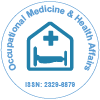Health Access: A Fundamental Right for All
Received: 01-Mar-2025 / Manuscript No. omha-25-170282 / Editor assigned: 03-Mar-2025 / PreQC No. omha-25-170282 / Reviewed: 17-Mar-2025 / QC No. omha-25-170282 / Revised: 22-Mar-2025 / Manuscript No. omha-25-170282 / Published Date: 29-Mar-2025
Introduction
Access to healthcare is a basic human right, yet millions of people around the world still face significant barriers to receiving the care they need. Health access refers to the ability of individuals to obtain timely, affordable, and quality medical services, including preventive, curative, and palliative care. Ensuring equitable access to healthcare is essential not only for individual well-being but also for building healthier, more productive societies [1]. As global health systems evolve, the focus must remain on breaking down barriers to access and making healthcare inclusive for all [2],[3].
Discussion
Barriers to health access can be economic, geographic, social, or systemic. In many low- and middle-income countries, cost remains the most significant barrier. People living in poverty often cannot afford doctor visits, medications, or transportation to health facilities. Even in wealthier nations, high out-of-pocket expenses and lack of insurance coverage prevent many from seeking care when they need it [4],[5].
Geographical barriers also limit access, particularly in rural and remote areas where healthcare infrastructure is limited. Long travel distances, poor roads, and shortages of trained medical professionals mean that people in these regions often go untreated or face delays in receiving care. This gap is particularly severe in emergency situations or for chronic conditions requiring regular monitoring [6],[7].
Social determinants of health—such as education, employment, and housing—also influence access. Marginalized communities, including ethnic minorities, refugees, women, and people with disabilities, often face discrimination or lack culturally sensitive services. Language barriers and health illiteracy further complicate efforts to reach these populations [8],[9].
Systemic issues, such as understaffed health facilities, long waiting times, and inefficient referral systems, contribute to poor access even when services are available. Health systems must be strengthened to provide quality care that is timely and responsive to patient needs [10].
Despite these challenges, there are promising strategies and innovations improving access. The expansion of universal health coverage (UHC) aims to ensure that all individuals receive the health services they need without suffering financial hardship. Countries implementing UHC models have seen significant progress in reducing health disparities and improving population health.
Telemedicine and digital health have emerged as powerful tools to overcome geographical and time barriers. Remote consultations, online health education, and mobile health apps enable patients to access care from their homes, particularly useful in rural and underserved areas.
Community-based healthcare models, such as mobile clinics and health outreach programs, have also proven effective in reaching vulnerable populations. Training local health workers to deliver primary care, vaccinations, and health education helps build trust and sustainability in communities.
Conclusion
Health access is a cornerstone of public health and social justice. Without it, inequalities grow, diseases spread, and lives are lost unnecessarily. Addressing the multifaceted barriers to healthcare—economic, geographic, and systemic—requires coordinated efforts from governments, healthcare providers, and communities. Through inclusive policies, innovative solutions, and a commitment to equity, we can move closer to a world where everyone, regardless of their background or location, can access the care they deserve. Health for all is not just a goal—it is a shared responsibility.
Reference
- Olivera CM, Vianna EO, Bonizio RC, de Menezes MB, Ferraz E et al. (2016) Asthma self-management model: randomized controlled trial. Health education research, 31(5), 639–652.
- Farias RV, Morais AC, Matos AV, de AV Educação em saúde com crianças sobre a infecção pelo novo coronavírus: Relato de experiência. Temas em Educação e Saúde, Araraquara, v. 18, n. 00, p. e022007, 2022.
- Machado V A, Pinheiro R, Miguez S F (2021) Education and freedom in school health promotion: comprehensive perspectives on political action as a power in school communities. Interface (Botucatu). 25: e200035.
- Jomezadeh N, Babamoradi S, Kalantar E, Javaherizadeh H (2014) Isolation and antibiotic susceptibility of Shigella species from stool samplesamong hospitalized children in Abadan, Iran. Gastroenterol Hepatol Bed Bench 7: 218.
- Stellefson M, Paige SR, Chaney BH, & Chaney JD (2020). Evolving Role of Social Media in Health Promotion: Updated Responsibilities for Health Education Specialists. International journal of environmental research and public health, 17(4), 1153.
- Benes S, Boyd KM, Cucina I, & Alperin HL (2021). School-Based Health Education Research: Charting the Course for the Future. Research quarterly for exercise and sport, 92(1), 111–126.
- Nutbeam D. (2021) From health education to digital health literacy - building on the past to shape the future. Global health promotion, 28(4), 51–55.
- Ministry of Health. Executive Secretary. Secretariat of Work and Health. Education Management. Thematic glossary: management of work and education in health/ Ministry of Health. Executive Secretary. Secretariat for Management of Work and Education in Health, 2nd ed, 2nd reprint. - Brasilia: Ministry of Health, 2013.
- Nekola L, Tucker J, Locke E, Chermak E, Marshall T (2022) Pediatric interprofessional education opportunities in the entry-level doctor of physical therapy programs. Journal of Interprofessional Education & Practice, 29.
- World Health Organization. (2023) Health promoting schools.
Citation: Ashley J (2025) Health Access: A Fundamental Right for All. Occup Med Health 13: 573.
Copyright: © 2025 Ashley J. This is an open-access article distributed under the terms of the Creative Commons Attribution License, which permits unrestricted use, distribution, and reproduction in any medium, provided the original author and source are credited.
Select your language of interest to view the total content in your interested language
Share This Article
Recommended Journals
Open Access Journals
Article Usage
- Total views: 276
- [From(publication date): 0-0 - Dec 12, 2025]
- Breakdown by view type
- HTML page views: 209
- PDF downloads: 67
